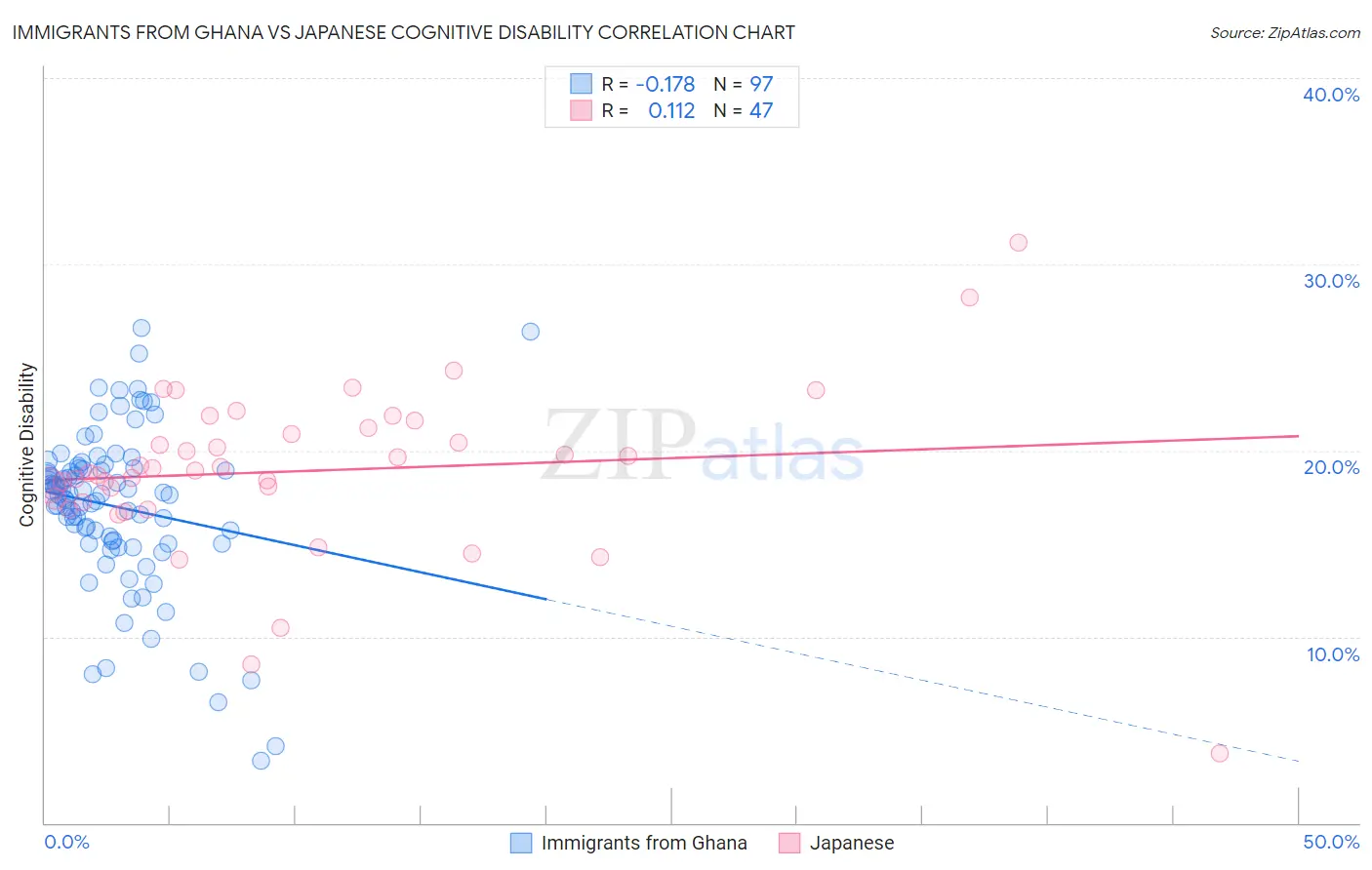Immigrants from Ghana vs Japanese Cognitive Disability
COMPARE
Immigrants from Ghana
Japanese
Cognitive Disability
Cognitive Disability Comparison
Immigrants from Ghana
Japanese
18.3%
COGNITIVE DISABILITY
0.0/ 100
METRIC RATING
301st/ 347
METRIC RANK
18.3%
COGNITIVE DISABILITY
0.0/ 100
METRIC RATING
298th/ 347
METRIC RANK
Immigrants from Ghana vs Japanese Cognitive Disability Correlation Chart
The statistical analysis conducted on geographies consisting of 199,902,948 people shows a poor negative correlation between the proportion of Immigrants from Ghana and percentage of population with cognitive disability in the United States with a correlation coefficient (R) of -0.178 and weighted average of 18.3%. Similarly, the statistical analysis conducted on geographies consisting of 249,155,070 people shows a poor positive correlation between the proportion of Japanese and percentage of population with cognitive disability in the United States with a correlation coefficient (R) of 0.112 and weighted average of 18.3%, a difference of 0.20%.

Cognitive Disability Correlation Summary
| Measurement | Immigrants from Ghana | Japanese |
| Minimum | 3.4% | 3.7% |
| Maximum | 26.6% | 31.2% |
| Range | 23.2% | 27.4% |
| Mean | 17.0% | 18.9% |
| Median | 17.6% | 18.9% |
| Interquartile 25% (IQ1) | 15.1% | 17.2% |
| Interquartile 75% (IQ3) | 19.1% | 21.2% |
| Interquartile Range (IQR) | 4.0% | 4.0% |
| Standard Deviation (Sample) | 4.3% | 4.5% |
| Standard Deviation (Population) | 4.3% | 4.4% |
Demographics Similar to Immigrants from Ghana and Japanese by Cognitive Disability
In terms of cognitive disability, the demographic groups most similar to Immigrants from Ghana are Barbadian (18.3%, a difference of 0.080%), Immigrants from Kenya (18.3%, a difference of 0.090%), Creek (18.3%, a difference of 0.14%), Immigrants from Eritrea (18.3%, a difference of 0.15%), and Ghanaian (18.3%, a difference of 0.17%). Similarly, the demographic groups most similar to Japanese are Blackfeet (18.3%, a difference of 0.0%), Ghanaian (18.3%, a difference of 0.030%), Creek (18.3%, a difference of 0.060%), Immigrants from Burma/Myanmar (18.2%, a difference of 0.14%), and German Russian (18.2%, a difference of 0.17%).
| Demographics | Rating | Rank | Cognitive Disability |
| Natives/Alaskans | 0.1 /100 | #289 | Tragic 18.1% |
| Immigrants | Africa | 0.1 /100 | #290 | Tragic 18.1% |
| Ottawa | 0.1 /100 | #291 | Tragic 18.2% |
| Iroquois | 0.1 /100 | #292 | Tragic 18.2% |
| Central American Indians | 0.1 /100 | #293 | Tragic 18.2% |
| British West Indians | 0.1 /100 | #294 | Tragic 18.2% |
| German Russians | 0.0 /100 | #295 | Tragic 18.2% |
| Immigrants | Burma/Myanmar | 0.0 /100 | #296 | Tragic 18.2% |
| Blackfeet | 0.0 /100 | #297 | Tragic 18.3% |
| Japanese | 0.0 /100 | #298 | Tragic 18.3% |
| Ghanaians | 0.0 /100 | #299 | Tragic 18.3% |
| Creek | 0.0 /100 | #300 | Tragic 18.3% |
| Immigrants | Ghana | 0.0 /100 | #301 | Tragic 18.3% |
| Barbadians | 0.0 /100 | #302 | Tragic 18.3% |
| Immigrants | Kenya | 0.0 /100 | #303 | Tragic 18.3% |
| Immigrants | Eritrea | 0.0 /100 | #304 | Tragic 18.3% |
| Colville | 0.0 /100 | #305 | Tragic 18.3% |
| Seminole | 0.0 /100 | #306 | Tragic 18.3% |
| Ugandans | 0.0 /100 | #307 | Tragic 18.3% |
| Immigrants | Western Africa | 0.0 /100 | #308 | Tragic 18.4% |
| Immigrants | Eastern Africa | 0.0 /100 | #309 | Tragic 18.4% |